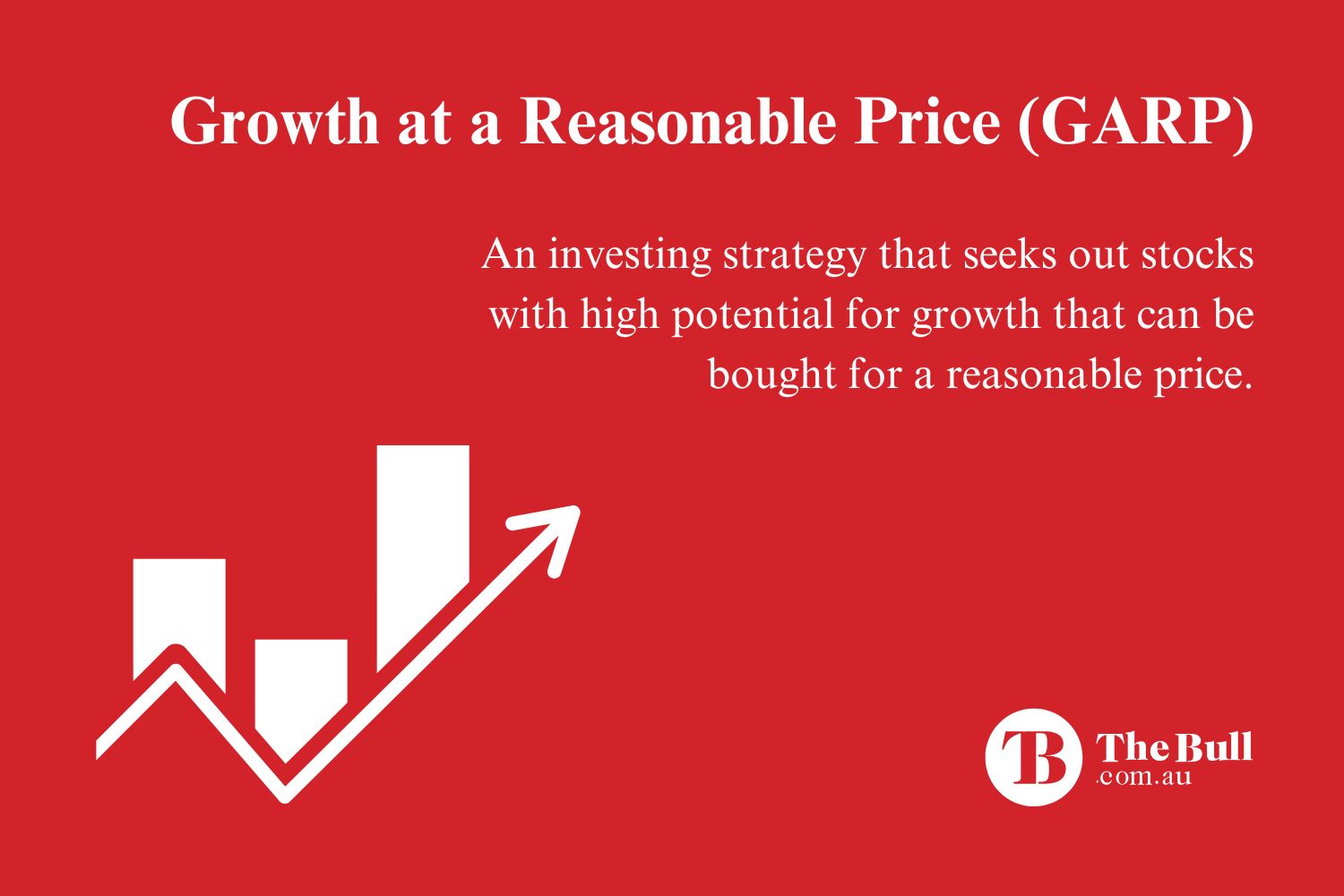Combining Strategies with Growth at a Reasonable Price (GARP) Investing
Newcomers to share market investing quickly learn there are two major categories of stocks around which they can build their trading strategy – Value stocks and Growth stocks.
Investing in either category requires an assessment of the fundamentals of the company’s business. This fundamental analysis is the opposite approach of another investing strategy – technical analysis where investors are primarily interested in stock price performance over time.
Value stocks are often referred to as “bargain stock” since in the eyes of value investors market participants are ignoring the fundamentals of the company., The belief is that at some point market participants will catch on to the true value of these bargain stocks and the price will rise. Value stocks typically have low Price to Earnings ratios and often feature high dividend yields – the bellwether valuation ratio used by all fundamental analysis investors. A P/E of 15 or lower is the target for value investors. The ratio is calculated by dividing the price per share of the stock by the reported earnings per share.

Top Australian Brokers
- Pepperstone - Trading education - Read our review
- IC Markets - Experienced and highly regulated - Read our review
- eToro - Social and copy trading platform - Read our review
Growth investors gravitate towards stocks with high P/Es as they see this as a sign market participants are wiling to pay more than the stock is worth based on valuation metrics in anticipation of big moves in the stock price over time. Many growth stocks do not pay dividends, preferring to reinvest in the company’s future growth.
Value investors look at growth stocks as vastly overpriced, while growth investors look at value stocks as being “cheap for a reason,” with the reason being the value stock company does not have a positive future.
What is Growth at a Reasonable Price (GARP)?
Peter Lynch was the fund manager of the Magellan Mutual Fund for fidelity investments. Lynch managed the fund between 1977 and 1990, with a stunning annual return of 29.2%. Magellan had assets of $18 million dollars when he took over the fund and $14 billion dollars when he left.
One day Lynch posed the question – Why not growth at a reasonable price? And the GARP investing strategy was born.
The gold standard valuation metric for GARP investors is the P/EG ratio, (Price to Earnings Growth), developed by Lynch.
The P/E ratio looks backward at historical earnings per share, sometimes over a year and sometimes since the last reporting period. Seasoned investors like to remind newcomers that share markets are forward looking. Rear view mirrors can be faulty. The P/EG replaces historical earnings per share, with anticipated future earnings per share, with some using the EPS growth estimated by the company and some using consensus analyst estimates.
A P/EG of 1.0 indicates the stocks is fairly priced and P/EGs under 1.0 indicate the stock is undervalued. Lynch later improved on the ratio by adding dividend yield to the calculation, creating the dividend adjusted P/EGY ratio. The P/EGY ratio adds dividend yield to the projected growth rate in the denominator of the calculation formula.
How to Invest with the GARP Strategy
The simplest way to invest with the GARP strategy is through an index fund that follows the GARP strategy, If you have access to US equities, look into Fidelity Growth Strategies or T. Rowe Price Blue Chip Growth. Here in Australia , Global X introduced the first GARP ETF (exchange traded fund), the S&P World Ex-Australia GARP ETF (ASX: GARP). However, the fund does not include ASX stocks, focusing on large-cap and mid-cap stocks of developed companies around the world.
A stock screener is essential for investing with the GARP strategy. In Australia free stock screeners are hard to find and limited. The better online investing platforms have them and there are dedicated stock screener programs for purchase.
The critical criteria would be the P/EG, a low P/E and Price to Book (P/B) ratio along with dividend yield. GARP is essentially a “middle” of the road “ strategy so many GARP investors would not shy away from P/E ratios between 15 and 25.
As is the case with any investment using fundamental analysis, the process does not end with attractive valuation metrics.
Debt Levels, cash flow, liquidity, profitability ratios like gross margins and operating margins, and return on equity and return on assets need to be assessed. Valuation ratios alone will not uncover critical information on how efficient and effective the company’s operating performance is.
GARP Investing Advantages
GARP investors restrict their search to companies that are showing a profit, while true growth investors may target startup companies with promising products that have yet to deliver any profit.
The “middle of the road” approach broadens the potential target market of stocks for investors while true value and growth investors limit themselves to the extremes.
Expanding the potential universe of investable stocks means more predictable returns through a variety of market cycles where growth and value stocks outperform their counterparts. With the GARP investment strategy, value investors would be willing to pay a reasonable price for a stock with high growth potential while a growth investor would be more likely to take a chance on a company currently under the radar of most market participants.
Finally, GARP portfolios reduce the risk associated with bargain stocks that never bear fruit and growth stocks that fail to deliver, crashing the share price.
GARP Investing Drawbacks
Pure growth investing can produce greater returns than a growth leaning stock selected under GARP criteria, but the risk is substantially higher. Many growth stocks are dramatically overpriced, making many investors ready to head to the exit doors at the first sign of trouble.
Time is another drawback to the GARP investment strategy. The stock market adage to “beware the falling knife” suggests a stock with a rapidly declining price that could qualify as a GARP investment may see its share price continue to tumble downward in free fall. Researching value stocks is a time intensive process, requiring a higher level of due diligence than a growth stock garnering the attention of analysts and market experts. While glamorous growth leaning GROWTH stocks give investors resources to read about the company while in many cases, beaten-down value leaning stocks have little if any attention in the financial press.
The Growth at A Reasonable Price (GARP) investing strategy combines elements of traditional growth and value investing strategies. While value investors look for undervalued stocks based largely on P/E ratios under 15, growth investors look for stocks with high P/Es they see as evidence marker participants are convinced the stock has substantial future growth prospects. GARP investors take a middle of the road stance, looking for stocks with P/Es between 15 and 25. The Price to Earnings Growth ratio (P/EG) is the gold standard for GARP investors, with a P/EG at 1.0 indicating the stock is price at fair value and P/EGs under 1.0 indicating the stock is undervalued.





